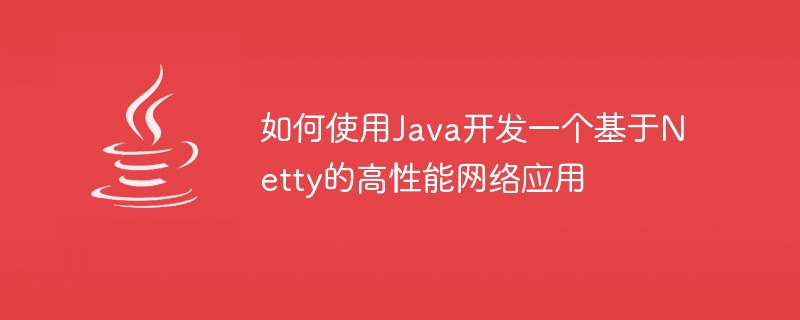如何使用Java開發一個基於Netty的高效能網頁應用

如何使用Java開發一個基於Netty的高效能網路應用
Netty是一種基於Java NIO技術的網路程式框架,被廣泛應用於高效能的網路應用開發。在本文中,我們將探討如何使用Java和Netty來開發一個基於Netty的高效能網路應用。我們將介紹Netty的基本概念和特性,並提供一些程式碼範例以幫助你更好地理解和使用Netty。
一、Netty的基本概念和特性
Netty是一個基於事件驅動的非同步網路程式框架,它提供了高度可自訂的線程模型和協議的抽象,使得我們可以輕鬆地開發出高效能和可擴展的網路應用程式。
- 非同步和事件驅動:Netty採用非同步和事件驅動的方式處理網路操作,不再以阻塞的方式等待網路資料的傳輸。透過註冊事件監聽器,當有事件發生時,Netty會呼叫指定的回呼方法進行處理。
- 高效能:Netty採用了一些最佳化技術,如零拷貝、記憶體池等,以提高網路傳輸效率和減少資源消耗。
- 可擴展性和靈活性:Netty提供了一套靈活的API和可插拔的元件,使得我們能夠自訂協定和業務邏輯,實現高度可擴展的網路應用。
- 安全性:Netty提供了一些安全框架和元件,使得我們可以輕鬆實現SSL或TLS協議,確保網路傳輸的安全性。
二、Netty的核心元件
- Channel
Channel是Netty中最基本的元件,它負責資料的讀寫和處理通道的生命週期。在Netty中,Channel是由Transport實現的底層傳輸,如NIO、OIO、Epoll等。 - EventLoop
EventLoop是Netty中的事件循環器,負責處理IO事件、任務調度和連線管理等。一個EventLoop可以有多個Channel,一個Channel只會綁定一個EventLoop。 - ChannelPipeline
ChannelPipeline是處理Channel中的資料流的元件,它由多個ChannelHandler組成。當資料流經過ChannelPipeline時,會依照順序依序經過各個ChannelHandler進行處理。 - ChannelHandler
ChannelHandler是Netty中最重要的元件。它負責處理事件和資料的讀寫,可以對協定進行解析和業務邏輯進行處理。
三、使用Netty開發高效能網頁應用程式
#下面我們將透過一個簡單的範例來示範如何使用Netty開發一個高效能的網路應用程式。在這個範例中,我們將建立一個簡單的Echo伺服器,它會將客戶端所傳送的訊息傳回給客戶端。
- 建立一個Echo伺服器
首先,我們需要建立一個Echo伺服器,它會監聽來自客戶端的連接,並處理讀寫事件。
public class EchoServer {
private final int port;
public EchoServer(int port) {
this.port = port;
}
public void start() throws Exception {
EventLoopGroup group = new NioEventLoopGroup();
try {
ServerBootstrap bootstrap = new ServerBootstrap();
bootstrap.group(group)
.channel(NioServerSocketChannel.class)
.localAddress(new InetSocketAddress(port))
.childHandler(new ChannelInitializer<SocketChannel>() {
@Override
public void initChannel(SocketChannel ch) throws Exception {
ch.pipeline().addLast(new EchoServerHandler());
}
});
ChannelFuture future = bootstrap.bind().sync();
future.channel().closeFuture().sync();
} finally {
group.shutdownGracefully().sync();
}
}
public static void main(String[] args) throws Exception {
int port = 8888;
new EchoServer(port).start();
}
}- 建立一個EchoServerHandler
接下來,我們需要建立一個EchoServerHandler,它會處理每個連接的讀寫事件,並將接收到的訊息傳回給客戶端。
public class EchoServerHandler extends ChannelInboundHandlerAdapter {
@Override
public void channelRead(ChannelHandlerContext ctx, Object msg) throws Exception {
ctx.writeAndFlush(msg);
}
@Override
public void exceptionCaught(ChannelHandlerContext ctx, Throwable cause) throws Exception {
cause.printStackTrace();
ctx.close();
}
}- 建立一個Echo客戶端
最後,我們需要建立一個Echo客戶端來測試我們的Echo伺服器。
public class EchoClient {
private final String host;
private final int port;
public EchoClient(String host, int port) {
this.host = host;
this.port = port;
}
public void start() throws Exception {
EventLoopGroup group = new NioEventLoopGroup();
try {
Bootstrap bootstrap = new Bootstrap();
bootstrap.group(group)
.channel(NioSocketChannel.class)
.remoteAddress(new InetSocketAddress(host, port))
.handler(new ChannelInitializer<SocketChannel>() {
@Override
public void initChannel(SocketChannel ch) throws Exception {
ch.pipeline().addLast(new EchoClientHandler());
}
});
ChannelFuture future = bootstrap.connect().sync();
future.channel().closeFuture().sync();
} finally {
group.shutdownGracefully().sync();
}
}
public static void main(String[] args) throws Exception {
String host = "localhost";
int port = 8888;
new EchoClient(host, port).start();
}
}- 建立一個EchoClientHandler
與EchoServer類似,我們還需要建立一個EchoClientHandler來處理客戶端的讀寫事件。
public class EchoClientHandler extends ChannelInboundHandlerAdapter {
private final ByteBuf message;
public EchoClientHandler() {
message = Unpooled.buffer(256);
for (int i = 0; i < message.capacity(); i++) {
message.writeByte((byte) i);
}
}
@Override
public void channelActive(ChannelHandlerContext ctx) throws Exception {
ctx.writeAndFlush(message);
}
@Override
public void channelRead(ChannelHandlerContext ctx, Object msg) throws Exception {
ctx.write(msg);
}
@Override
public void channelReadComplete(ChannelHandlerContext ctx) throws Exception {
ctx.flush();
}
@Override
public void exceptionCaught(ChannelHandlerContext ctx, Throwable cause) throws Exception {
cause.printStackTrace();
ctx.close();
}
}四、總結
使用Java和Netty開發高效能網路應用可以大幅提升應用的穩定性和效能。本文介紹了Netty的基本概念和特性,並提供了一個簡單的範例讓讀者深入理解。透過學習和實踐,開發者可以更好地掌握Netty的用法,從而開發出更有效率和可靠的網路應用程式。
以上是如何使用Java開發一個基於Netty的高效能網頁應用的詳細內容。更多資訊請關注PHP中文網其他相關文章!

熱AI工具

Undresser.AI Undress
人工智慧驅動的應用程序,用於創建逼真的裸體照片

AI Clothes Remover
用於從照片中去除衣服的線上人工智慧工具。

Undress AI Tool
免費脫衣圖片

Clothoff.io
AI脫衣器

Video Face Swap
使用我們完全免費的人工智慧換臉工具,輕鬆在任何影片中換臉!

熱門文章

熱工具

記事本++7.3.1
好用且免費的程式碼編輯器

SublimeText3漢化版
中文版,非常好用

禪工作室 13.0.1
強大的PHP整合開發環境

Dreamweaver CS6
視覺化網頁開發工具

SublimeText3 Mac版
神級程式碼編輯軟體(SublimeText3)
 PHP與Python:了解差異
Apr 11, 2025 am 12:15 AM
PHP與Python:了解差異
Apr 11, 2025 am 12:15 AM
PHP和Python各有優勢,選擇應基於項目需求。 1.PHP適合web開發,語法簡單,執行效率高。 2.Python適用於數據科學和機器學習,語法簡潔,庫豐富。
 PHP:網絡開發的關鍵語言
Apr 13, 2025 am 12:08 AM
PHP:網絡開發的關鍵語言
Apr 13, 2025 am 12:08 AM
PHP是一種廣泛應用於服務器端的腳本語言,特別適合web開發。 1.PHP可以嵌入HTML,處理HTTP請求和響應,支持多種數據庫。 2.PHP用於生成動態網頁內容,處理表單數據,訪問數據庫等,具有強大的社區支持和開源資源。 3.PHP是解釋型語言,執行過程包括詞法分析、語法分析、編譯和執行。 4.PHP可以與MySQL結合用於用戶註冊系統等高級應用。 5.調試PHP時,可使用error_reporting()和var_dump()等函數。 6.優化PHP代碼可通過緩存機制、優化數據庫查詢和使用內置函數。 7
 突破或從Java 8流返回?
Feb 07, 2025 pm 12:09 PM
突破或從Java 8流返回?
Feb 07, 2025 pm 12:09 PM
Java 8引入了Stream API,提供了一種強大且表達力豐富的處理數據集合的方式。然而,使用Stream時,一個常見問題是:如何從forEach操作中中斷或返回? 傳統循環允許提前中斷或返回,但Stream的forEach方法並不直接支持這種方式。本文將解釋原因,並探討在Stream處理系統中實現提前終止的替代方法。 延伸閱讀: Java Stream API改進 理解Stream forEach forEach方法是一個終端操作,它對Stream中的每個元素執行一個操作。它的設計意圖是處
 PHP與其他語言:比較
Apr 13, 2025 am 12:19 AM
PHP與其他語言:比較
Apr 13, 2025 am 12:19 AM
PHP適合web開發,特別是在快速開發和處理動態內容方面表現出色,但不擅長數據科學和企業級應用。與Python相比,PHP在web開發中更具優勢,但在數據科學領域不如Python;與Java相比,PHP在企業級應用中表現較差,但在web開發中更靈活;與JavaScript相比,PHP在後端開發中更簡潔,但在前端開發中不如JavaScript。
 PHP與Python:核心功能
Apr 13, 2025 am 12:16 AM
PHP與Python:核心功能
Apr 13, 2025 am 12:16 AM
PHP和Python各有優勢,適合不同場景。 1.PHP適用於web開發,提供內置web服務器和豐富函數庫。 2.Python適合數據科學和機器學習,語法簡潔且有強大標準庫。選擇時應根據項目需求決定。
 PHP的影響:網絡開發及以後
Apr 18, 2025 am 12:10 AM
PHP的影響:網絡開發及以後
Apr 18, 2025 am 12:10 AM
PHPhassignificantlyimpactedwebdevelopmentandextendsbeyondit.1)ItpowersmajorplatformslikeWordPressandexcelsindatabaseinteractions.2)PHP'sadaptabilityallowsittoscaleforlargeapplicationsusingframeworkslikeLaravel.3)Beyondweb,PHPisusedincommand-linescrip
 PHP:許多網站的基礎
Apr 13, 2025 am 12:07 AM
PHP:許多網站的基礎
Apr 13, 2025 am 12:07 AM
PHP成為許多網站首選技術棧的原因包括其易用性、強大社區支持和廣泛應用。 1)易於學習和使用,適合初學者。 2)擁有龐大的開發者社區,資源豐富。 3)廣泛應用於WordPress、Drupal等平台。 4)與Web服務器緊密集成,簡化開發部署。
 PHP與Python:用例和應用程序
Apr 17, 2025 am 12:23 AM
PHP與Python:用例和應用程序
Apr 17, 2025 am 12:23 AM
PHP適用於Web開發和內容管理系統,Python適合數據科學、機器學習和自動化腳本。 1.PHP在構建快速、可擴展的網站和應用程序方面表現出色,常用於WordPress等CMS。 2.Python在數據科學和機器學習領域表現卓越,擁有豐富的庫如NumPy和TensorFlow。






